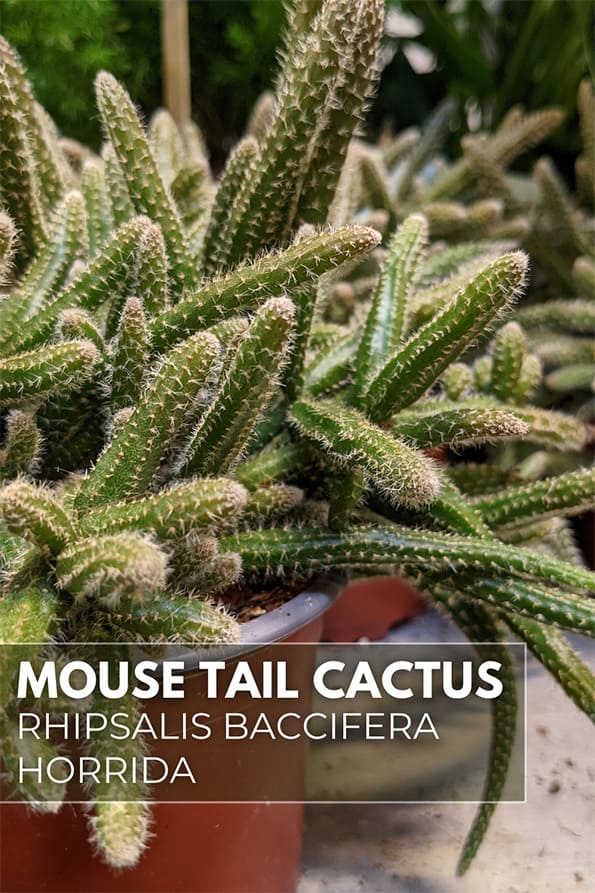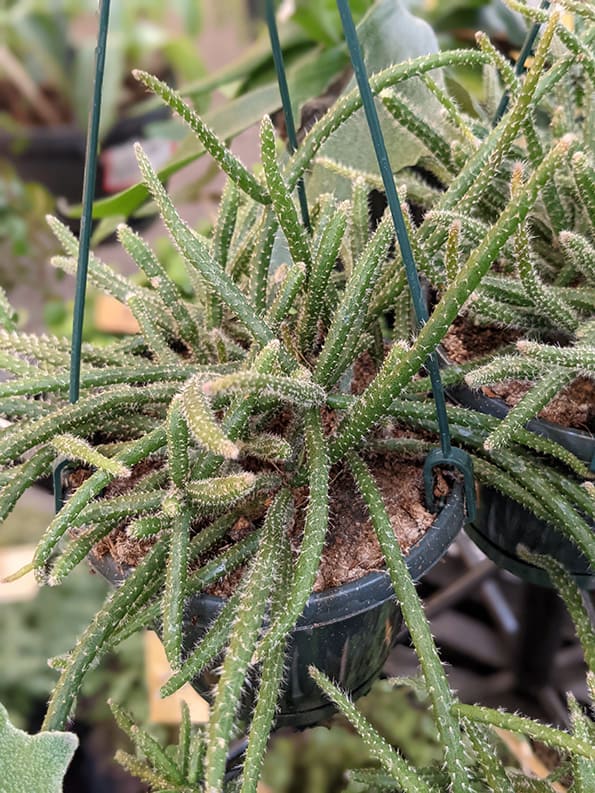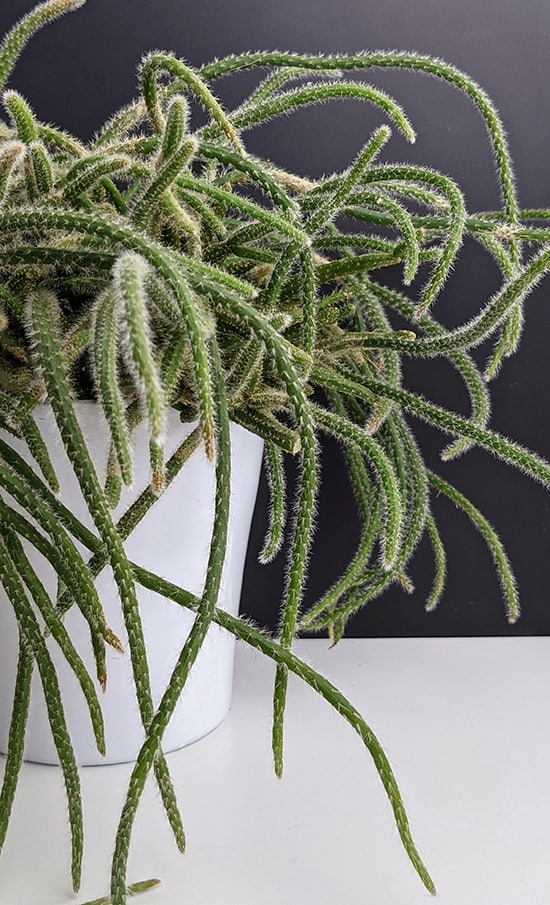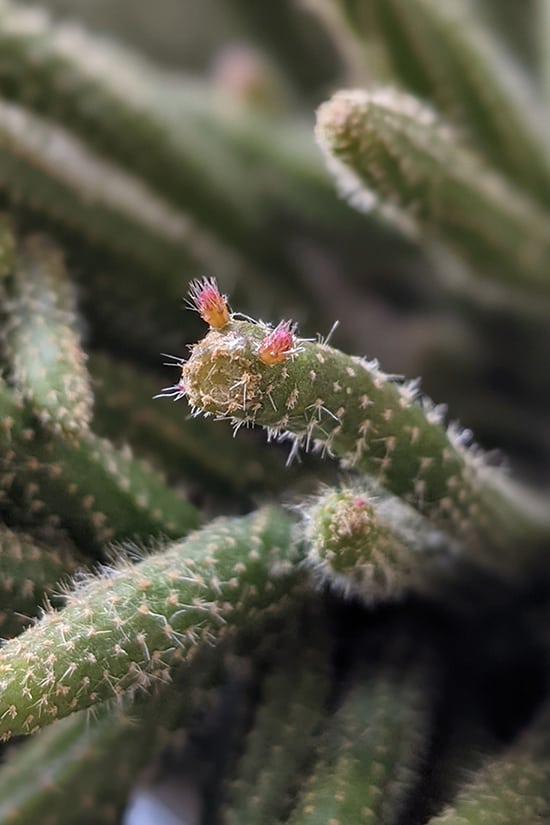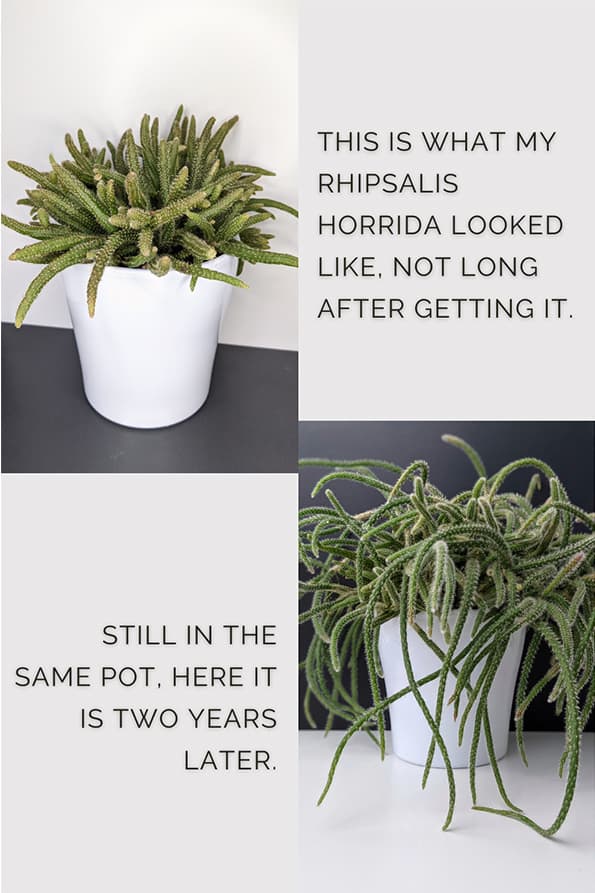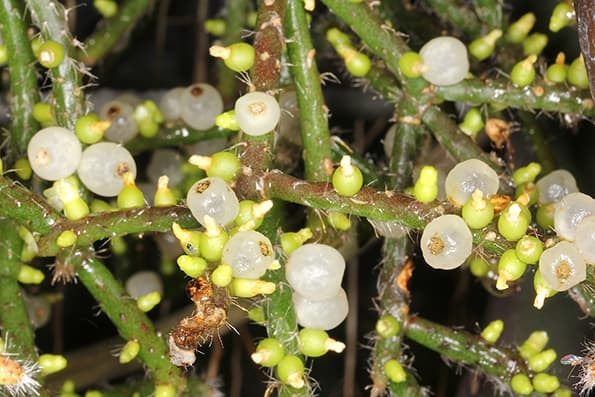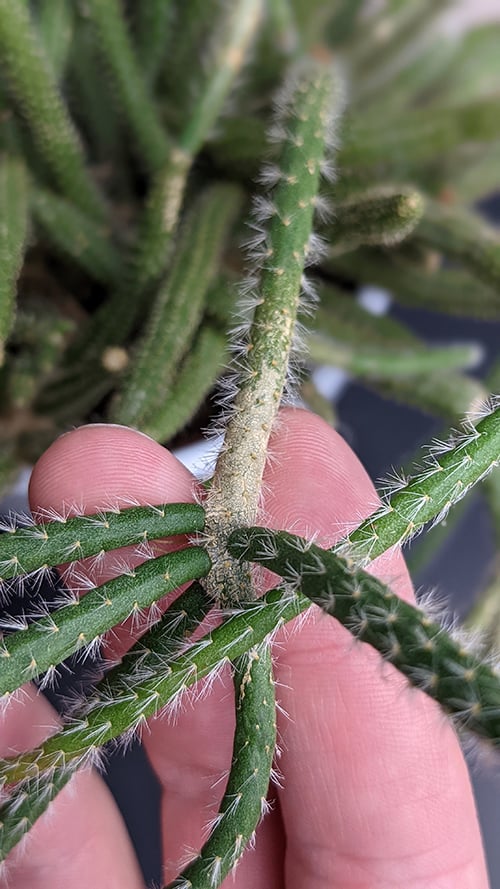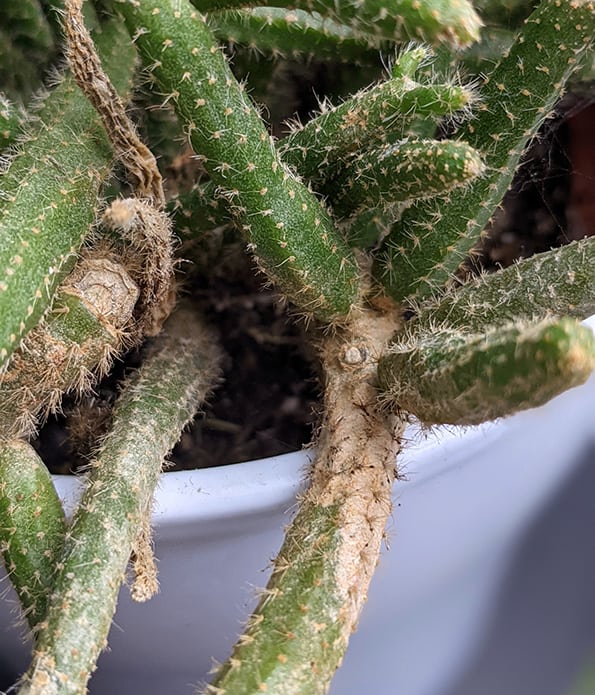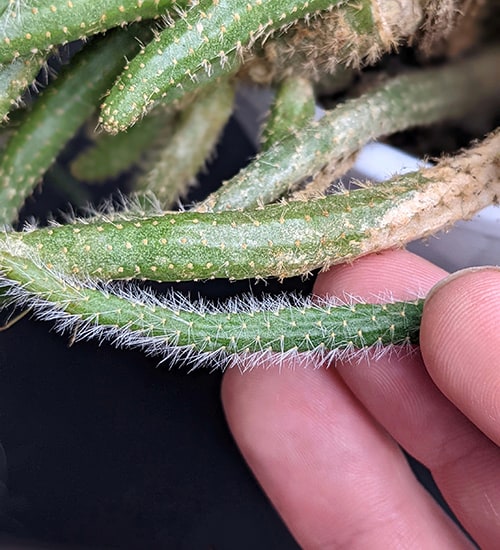The Mouse Tail Cactus (Rhipsalis Baccifera Horrida) is a weird indoor plant. Sometimes I think it's incredible, at other times I really don't like it.
I've had mine for several years now and I still can't decide what I think about it. But I'll tell you one thing I do know for sure. This is a ridiculously easy care houseplant.
It's put up with some really sloppy care from me over the years, and it's not even fazed. I'll cover more of my experiences in the full care guide shortly.
Rhipsalis is a genus of epiphytic cacti and is considered to be a jungle cactus. Like desert cacti, they have succulent qualities, but Rhipsalis plants need considerably less sunlight and more water to thrive.
Several Rhipsalis species are grown as houseplants. The most popular is Rhipsalis Baccifera, otherwise known as the Mistletoe Cactus. This is a close cousin to the subject of this article, the Mouse Tail Cactus (Rhipsalis baccifera subsp. horrida).
Whereas the Mistletoe Cactus has thin, hairless stems that gracefully hang down in long cascades, the Mouse Tail Cactus has much thicker stems. These are initially covered in white hairs, giving it a mouse tail look. When stroked, it even feels a little like a mouse tail.
How do you pronounce Rhipsalis baccifera horrida correctly?
Say:
Rip-Sar-Liss BAC-eee-fer-rar Ho-reed-da
Rhipsalis horrida, is an epiphytic tree-dwelling cactus native to South America. It looks fantastic and quirky when it's small and compact. However, over long periods the stems will become trailing and will hang down over the edge of the pot, so it will often look best as a hanging plant in the long term.
If you like its unusual look, this houseplant will be with you for the long haul due to its easy care needs and longevity.
These are not popular houseplants, but their easygoing nature makes them no-brainers for stores to sell. With this in mind, I've seen them popping up everywhere.
Do you like weird looking houseplants?
If you love the look of the Mouse Tail Cactus and like it when guests in your home say, "That's unusual," with a half-horrified look on their faces. Then you should check out The Rabbit Foot Fern and Ponytail Palm.
They are often sold in standard plastic containers, but you can get slightly longer ones in hanging baskets. Prices vary, but generally, $15 / £10 for a small plant should be your target price.
Larger plants, or those in hanging baskets are going to be more expensive. If you want an immediate impact go large, but even those smaller baby plants will reach a decent size within a few years so they'll soon catch up.
This undemanding plant can be sold in a wide range of planters. A simple nursery pot will do, but a hanging basket is a perfect way to show off its long stems (once they get long enough, of course!).
One big thing to watch out for from Online and in-person sellers is mislabeling. The Rhipsalis genus has many plants suitable as houseplants, and they can look similar when they're very young. It's often confused with Aporocactus flagelliformis too, which is an entirely different genus.
So how can you tell the difference?
Okay, let's get on with exploring the care requirements.

Hi, I'm Tom!
If you're like me and enjoy the challenge of growing houseplants and getting them to thrive, then Ourhouseplants can help. This website shares my knowledge and years of growing plants and provides (hopefully) helpful advice on properly caring for your indoor plant friends.
Epiphytic cacti will natively grow on other objects, like trees, meaning they expect direct sunlight to filter through the canopy during the day and some shade mixed in. This combination of light levels is what you want to replicate at home.
Light issues will take months to show up.
Rhipsalis plants need light
(like all plants!) but if you put them somewhere with very low light, they will hold their breath and freeze.
You won't get any growth, but nothing terrible is happening, either. This can fool new owners into thinking it's happy in this spot. If you don't see new growth after a few months, it's not a good place to grow it.
In a home setting they would be fine with some low light areas, but would need at least a few hours of sunlight. This is unlikely to be a situation most people can provide unless you have skylights.
If, like most of us, you have standard vertical windows, I'd recommend growing it within a few feet of an East or West facing window. For those in the Northern Hemisphere, South facing might be okay with some artificial shading or if set back into the room. But the stems might change to red if the light is too intense.
North facing can work, but ideally only if the plant is within a foot of the glass. If the light levels are too low, growth will be very slow, and what you get will be skinny and leggy. Your plant may also drop bits of its stems if the light is too low.
It has very forgiving watering requirements.
Mine is hidden away on a window ledge in a spare room. It gets water when I remember! Once or twice I've overwatered it and I've been horrified to find it sitting in an inch of water for weeks. It has been absolutely fine with either extreme. Not ideal, but good to know it can cope with mistakes.
They have a succulent nature, so they will store water in the stems for use in during droughts. Give them a good watering and then wait until at least half or more of the potting mix has dried out.
The potting mix can even dry out entirely for a week or two, but try not to leave it for any longer.
Overwatering can be an issue with succulent-type plants, but the Mouse Tail Cactus can cope with it far better than other succulents. Please don't read this as me saying you can be purposely careless. It just means it can deal with water pooling around its roots if it has to. But every plant will have a breaking point, so don't push it.
You might have heard they don't like high humidity, but nope, I'm not on board with this. They're forest dwellers natively, and these places can get quite damp and humid at times. This means they can be quite happy in steamy bathrooms and kitchens as much as in dry living rooms or bedrooms.
Unless you have serious humidity problems in your home, this Rhipsalis isn't going to be bothered about it.
They're not gross feeders, and quite happy with sporadic feeding during the year. I try to feed mine at least four times a year, but it's so easy going I don't keep a tally. Just don't overdo it and it'll be fine.
Use a standard houseplant feed or one designed for cacti and succulents.
You can watch my care guide over on YouTube.
Once again, it's very easy going with temperatures. Anything you can provide will be okay, as long as it's not too cold. 10°C (50°F) and up. Generally speaking, warmer temperatures will be needed for growth to actually take place.
The root system is not particularly robust and they are perfectly happy being slightly pot-bound for several years. However, if you notice your plant has stopped growing, or the stems have taken over, and you just need something bigger, it's time to repot it.
Pale green stems covered in fine bristles resembling mouse tails draw the eye. Give it a growing season or two and that white container could be hidden from view.
They're adaptable plants and can grow in straight potting compost with minimal drainage; not recommended! But it can be done. On the flip-side, they can thrive in some very free drainage mixes too. Again this is not ideal because it introduces new challenges, like underwatering and being too easy to knock out of its container.
Did you know?
The Mouse Tail Cactus is related to the Thanksgiving, Easter and Christmas Cactus. All are classed as jungle cacti. Prefering a humid atmosphere instead of a dry environment where desert cacti normally live.
My go to mix is peat-free standard potting compost with free drainage materials added like grit, perlite, or small chunks of bark. I rarely follow a strict ratio with potting mixes, but it will be something like 3 parts potting compost to 1 part sand, grit, etc.
To propagate new plants is relatively straightforward. You can divide them when you repot the plant or take cuttings.
By Division
Each container normally has multiple plants growing in them, each with one stem. They don't "spread" or develop replacements. All that happens is the original stem produces more growth points as the stem gets longer and longer.
This means that you lose the original cluster when you separate some of these stems and move them into new pots. It's fine if you want a more manageable looking plant, but if you want to keep the "bulk" it's better to take cuttings as detailed next.
By Cuttings
This is very simple.
At this point, you have a newly established plant. You can put multiple cuttings in the same planter for a more instant effect. One cutting will always look relatively sparse (obviously OK to do if that's the look you're going for).
I removed part of the stem from this mother plant and new shoots are forming near the cut edge. This will happen on yours too, so don't feel bad about taking cuttings. These "buds" should also appear on the actual cutting after a few months.
The small compact form often has more mass appeal than a mature specimen. It makes sense that if you've brought this plant from a shop, it will likely be a pretty small specimen, with several stems crammed into the container.
A lot of bright light with regular watering and medium to high temperatures is the key to rapid growth.
But as you already know by this point it's an easy going plant and will grow steadily all year round, even if you only provide semi decent care. So you'll still have a bushy Rhipsalis with many draping stems within a few years.
With decent light levels, growth is steady and noticeable. Especially when you have old photos you can look back on.
The stems often raise up a little before danging and hanging down the sides of the container. So how big it gets will depend on how much space they have below the pot. A plant growing on the edge of a bookcase or shelf could easily reach the floor after many years.
You can of course, easily control the length by pruning or taking cuttings if they're getting too long.
The plant will flower once it's old enough and getting enough light. The flowers are small and will last up to a week.
After this you can remove the faded blooms or leave them alone. However if you do many will turn into little berrylike fruits, white is typical (see photo below). But if your plant is a hybrid or cross, then you might get red or black berries instead.
The plant, its small flowers or seed pods aren't considered toxic. However, I don't recommend eating any of it, especially the berries (or letting others have a nibble) as they can cause an upset stomach.
The flowers are cute, but the berry-like fruits that come afterwards are another reason people say this plant gives them the creepy-crawlies. Photo by Peter A. Mansfeld
The bulk of the plants in the Rhipsalis genus are not considered toxic to people or pets. But they can be fragile to rough handling or playful pets, sufficient reason to keep them away from four-legged friends.
Stems Branching.
This isn't really a problem and more a natural growth habit. Often if the tip of a growing stem is damaged then new side shoots will grow.
This can happen after you take cuttings to propagate new plants, or perhaps if you've bashed the plant's stems while moving or repotting it.
Sometimes very healthy plants will just produce side shoots naturally. It's perfectly normal and not a sign of a problem.
With side shoots the plant can become very bushy, or perhaps even sprawling.
Stems dropping off.
Overwatering or too little light are going to be causing this (potentially both issues at the same time). Look back on it's recent care to try and establish what's gone wrong and how you can fix it.
Plant going red / purple.
Almost always caused by excessive light levels. When subjected to high light levels, plants will synthesize red or purple pigments called anthocyanins for self-protection. These pigments function similarly to sunscreen, absorbing surplus light energy to prevent potential tissue damage.
Sometimes owners will put them outside in warmer months for a holiday and fresh air (it's not essential to do) but this sudden increase in light intensity can cause this problem to be worse. It might look interesting but it's not a desired look on these plants, so if you catch it early enough it can be fully reversed. Simply move it back into a more shaded position.
Brown markings on the stems.
This is known as Corking and is standard on succulents, including the Mouse Tail Cactus. Generally, it's a defensive thing to help heal or protect the plant from something. A bit like how we get scabs over wounds, except with plants the browning doesn't ever go away.
Brown scab like markings on the stems of this Mouse Tail Cactus foliage. Although reasonably regular, it can make owners think they've done something wrong.
It can be caused by a few things.
Root Rot
Whilst not an overly common problem (Rhipsalis seem more resistant to this than other succulents), it can still occur with prolonged overwatering, especially over the Winter months when water is less needed anyway.
If you have very basic problems with just a few mushy stems, have a look at How to Save an overwatered succulent. If things are more extensive, then we have a Root Rot guide. However if it's extensive you will likely lose the bulk of the plant so it could be worth trying to propagate replacements and starting again.
Older stems are thicker and less hairy than newer ones.
Again this isn't a problem but the natural growth pattern of these plants.
New stems are almost always thinner and have loads more white hairs than the older parts of the plant.
It's thought that the new growth is tastier for predators than the established growth, so the white hairs act as a deterrent until they mature.
Side by side comparison of a mature stem vs a newer one. Note the older stem has lost the brustles, has a thicker stem and is a slightly different green color.
That's everything I have to say about this charming epiphytic cactus. Have you got your own Rhipsalis Baccifera Horrida? What do you think of it? Have you had any problems or different care tips to mine. Share them below, I'd love to hear them.
Credit for the plant in bloom (Article / Gallery) - Peter A. Mansfeld
